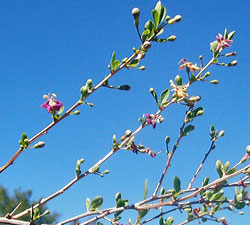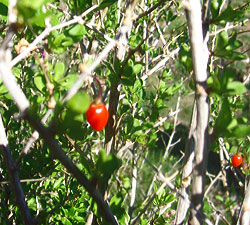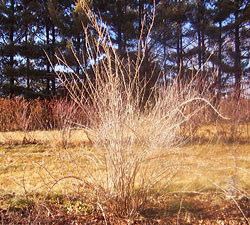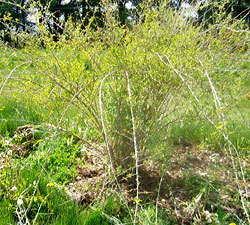
Gogi (Wolfberry)
(Lycium barbarum)

Flowering Gogi
Cultivar tested
unnamed selection
Description and site preference
Type and size – vine, but can be pruned and managed as a bush-like plant
Hardiness zone – 3-10 (some cultivars only 5-9)
Exposure – full sun or partial shade
Soil – moist, but needs high pH (7.4-8.4 is best)
Drainage – well-drained
Economic factors
Years to harvest – 2-3
Maintenance – specialized
Life of planting – 50+ years
Machine harvest potential – none (fruit very delicate)
Suitable markets – primarily juiced and dried

Gogi fruit
Notable features
Nutritional highlights – superfruit with high levels and wide range of nutraceutical content, though may be exaggerated (See Wikipedia reference, below.)
Adaptability – adapted well at test site, but fruiting sparse
Pest issues – none observed, claimed to be pest-free
Invasive potential – not known to be invasive, but can spread by lateral root shoots
Environmental benefits – has a taproot, should be a dynamic accumulator of minerals, potentially good insectary plant (flowers from June through September)
Integration characteristics
Shared management – somewhat low due to high pH requirement, specialized pruning
Shared equipment – low, harvesting very specialized
Shared processing – intermediate
Co-marketing – intermediate, primarily blended juice and dried, but new consumer products may be developed for locally grown fruit
Integration potential – conditional
Could be managed in an integrated production system, but adaptability, yields and economic sustainability are yet to be determined.

Dormant, unpruned Gogi
History and background
Gogi is very closely related to boxthorn in the family Solanaceae, which also includes potato, tomato, eggplant, deadly nightshade, chili pepper and tobacco. There are two species: L. chinense, grown commercially in southern China, and L. barbarum, grown in northern China. There is conflicting information about the characteristics of gogi, which may be due to the failure to distinguish between the two species. According to Wikipedia, gogi is native to southeastern Europe and Asia, but there is no distinction between the two species. Another source (see Pheonix Tears Nursery.) mentions that their L. barbarum is hardy in Zones 3-10, but some varieties are only hardy in Zones 5-9. Northwoods Nursery (see One Green World) first listed gogi as hardy to -20 degrees F (Zone 5), but now lists them as hardy only to -10 degrees F (Zone 6). There is also mention of a wide variance in fruitfulness.

Gogi with foliage
Observations at Carandale Farm
The unnamed cultivar in the test plot was ordered from Northwoods Nursery (see One Green World) in 2006 as L. barbarum, which is presumably the hardier of the two species (though it is now listed in their catalog as only being winter hardy to -10 degrees F).
• Plants established well and have shown good vigor.
• Cane dieback was an issue but seems to be less so as the plants age.
• Flowering starts in June with the heaviest bloom in August and September.
• Leaves are sparse, but there is no obvious disease or insect damage.
• There has been virtually no fruit set until September, and even that has been very sparse.
Discussion
Gogi is known to have a diverse micro-nutrient and phytochemical content, including 11 essential and 22 trace dietary minerals, 18 amino acids, 6 essential vitamins and numerous phenolic pigments (phenols) associated with antioxidant properties. Some of these components exist at high levels. Gogi deserves designation as a superfruit, but marketing claims often overstate potential health benefits with little or no scientifically supported evidence. (See Wikipedia reference, below.)
Gogi has been a mainstay for a healthy diet in Asia for thousands of years, but virtually unknown in North American until the start of the 21st century. It could become a valuable addition to the American diet as well as an economically significant cash crop for growers, but there is much to learn about cultivars, growing methods and its actual benefit as a functional food. The cultivar in the Carandale test plot has not been fruitful. This could be due to genetic reasons (unfruitful selection), soil issues (nutrient profile or pH) or management issues (pruning, etc.).
References
Wikipedia entry on Gogi
Phoenix Tears Nursery
Backyard Super Foods (University of Illinois Extension)
